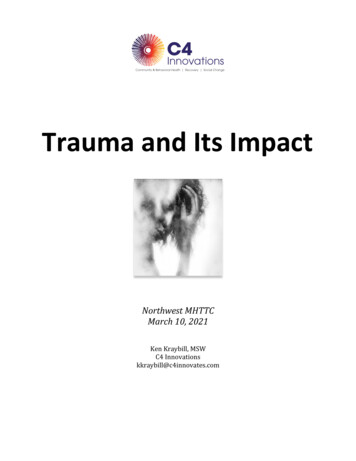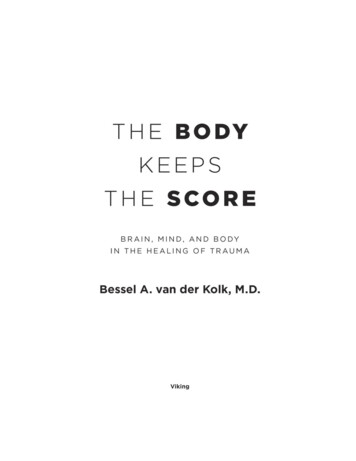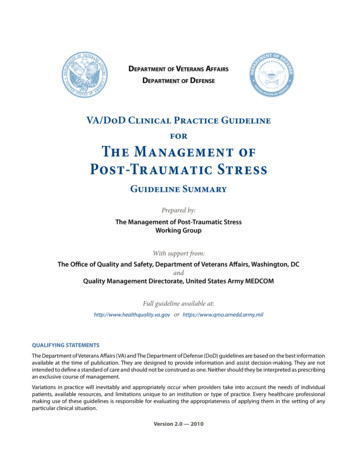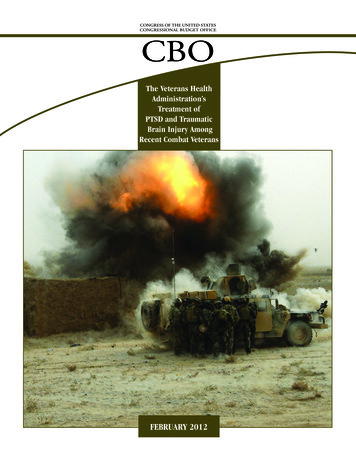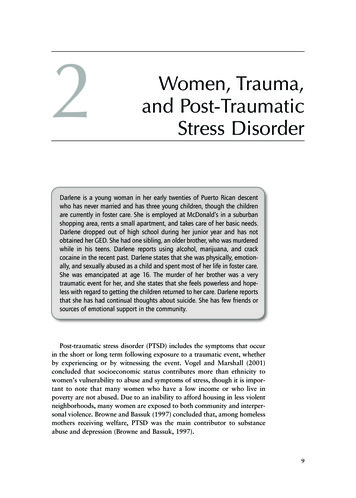
Transcription
2Women, Trauma,and Post-TraumaticStress DisorderDarlene is a young woman in her early twenties of Puerto Rican descentwho has never married and has three young children, though the childrenare currently in foster care. She is employed at McDonald’s in a suburbanshopping area, rents a small apartment, and takes care of her basic needs.Darlene dropped out of high school during her junior year and has notobtained her GED. She had one sibling, an older brother, who was murderedwhile in his teens. Darlene reports using alcohol, marijuana, and crackcocaine in the recent past. Darlene states that she was physically, emotionally, and sexually abused as a child and spent most of her life in foster care.She was emancipated at age 16. The murder of her brother was a verytraumatic event for her, and she states that she feels powerless and hopeless with regard to getting the children returned to her care. Darlene reportsthat she has had continual thoughts about suicide. She has few friends orsources of emotional support in the community.Post-traumatic stress disorder (PTSD) includes the symptoms that occurin the short or long term following exposure to a traumatic event, whetherby experiencing or by witnessing the event. Vogel and Marshall (2001)concluded that socioeconomic status contributes more than ethnicity towomen’s vulnerability to abuse and symptoms of stress, though it is important to note that many women who have a low income or who live inpoverty are not abused. Due to an inability to afford housing in less violentneighborhoods, many women are exposed to both community and interpersonal violence. Browne and Bassuk (1997) concluded that, among homelessmothers receiving welfare, PTSD was the main contributor to substanceabuse and depression (Browne and Bassuk, 1997).9
10Evidence-Based Practice With WomenClinical DescriptionNumerous symptoms are commonly seen when the trauma is an interpersonal stressor, specifically childhood sexual abuse, physical abuse in childhood, or domestic battering (American Psychiatric Association, 2000).Those symptoms include, but are not limited to: self-destructive and impulsivebehavior; somatic complaints; and feelings of shame, despair, and hopelessness. In young children, however, PTSD may present in the form of nightmares about monsters and of rescuing others or of threats to self or others.It is noteworthy that PTSD may also be associated with general medicalconditions that can be measured in terms of changes in vital signs, such asincreased heart rate and glandular activity.PrevalenceFindings in community-based studies show that the lifetime rate of PTSD is8% among adults in the United States (American Psychiatric Association,2000). By comparison, Breslau and Davis (1992) found in a large community sample that women are at greater risk than men of developing PTSDafter exposure to trauma (see also Breslau, Davis, Andreski, Peterson, &Schultz, 1997). Although Breslau and colleagues noted that the risk of PTSDamong all individuals is 9%, the risk for women is 13% and for men 6%.Exposure to multiple trauma experiences places both men and women atgreater risk of developing PTSD; it is women’s exposure to sexual assaultthat contributes to the gender difference in risk (Breslau et al., 1997).In the Trauma Recovery Project, a large epidemiological study designed toexamine multiple outcomes after major trauma, including PTSD, researchersfound that, depending on whether full or partial DSM diagnostic criteriawere used, women in the general population were 2.4 to 2.8 times more likelythan men to experience PTSD (Holbrook, Hoyt, Stein, & Sieber, 2002).Moreover, the researchers found that being female, perceiving threat to one’slife, and symptoms of acute stress disorder (ASD) significantly and independently predict risk of PTSD. The prevalence of PTSD among women takes onsalience when one considers its well-documented comorbidity with depression,generalized anxiety, and substance use and abuse disorder (SUD).It is important to note that ASD may precede PTSD and that panic disorder(PD) often co-occurs with PTSD. ASD refers to symptoms that one mightexperience within the first month following a traumatic event and prior to thePTSD diagnosis (see Bryant, 2006). Dissociation, or the feeling of beingdisconnected from one’s surroundings, may occur, and this may include havingno memories for an extended period of time. In addition to experiencing atraumatic event and reacting to it with strong feelings of fear, one mustexperience three of the following symptoms: numbness or detachment; beingdazed or unaware; feelings that people, places, and things are not real;
Chapter 2 Women, Trauma, and Post-Traumatic Stress Disorder11feelings of separateness; and being unable to recall key aspects of the traumaticexperience. Seeking treatment for ASD is critical in preventing PTSD.PD is more likely than ASD to co-occur with PTSD, as well as with depressionand SUD (see Nixon, Resick, & Griffen, 2004). A panic attack is the experience of intense fear or discomfort and must actually be experienced before adiagnosis can be made. For the diagnosis, four of the following symptomsmust be reported: pounding heart or increased heart rate; sweating; tremblingor shaking; feeling of suffocation; choking; chest pain; abdominal problems;dizziness; detachment; loss of control; fear of death; numbness; and chills orhot flashes.One must also have experienced an unexpected attack, and at least oneattack must be followed by a month or more of either concern about havingan additional panic attack, worry about the consequences of a panic attack,or a change in behavior due to the attack. It is possible to have panic attackswithout having the disorder. Approximately 13% of women with PTSDdevelop PD as compared to 7% of men with PTSD, which is likely due tohigh rates of childhood sexual abuse and physical abuse among women withpanic disorder. In addition, women are more likely than men to be raped.EtiologyGenetic factors may influence the risk of exposure to some forms of trauma,specifically as a result of differences in personality that contribute to environmental and behavioral choices of individuals (Gilbertson et al., 2002; Stein,Jang, Taylor, Vernon, & Livesley, 2002). If this is so, genes that influenceone’s vulnerability to assaultive trauma may also influence susceptibility toPTSD. In monkeys, researchers have found that serotonin may modulate theeffect of adversity in females but not in males (Barr et al., 2004), which maybe helpful in understanding responses of humans in certain stress-relatedsyndromes, including PTSD. In the case of childhood sexual abuse, researchers have found that the trauma may induce abnormal blood flow to thehippocampus, the part of the brain associated with memory, processingemotions, and visual perception (Bremner et al., 1999; Shors et al., 2001).In one study, researchers found that early trauma in women may result in asensitized stress system that responds in an overly active way to subsequentstresses (Heim et al., 2000).Using naturalistic, qualitative studies, researchers have explored the possibility that dissociation during and immediately following the trauma predicts PTSD. The research indicates that if one has an out-of-body experienceat the time the trauma occurs in order to protect herself or himself from beingemotionally overwhelmed by the traumatic event, that specific, acute dissociation predicts PTSD (Brewin & Holmes, 2003; Ozer, Best, Lipsey, & Weiss,2003). In contrast, using multivariate analysis, Briere, Scott, and Weathers(2005) found that persistent trauma-related dissociation is the best predictor
12Evidence-Based Practice With Womenof PTSD, and thus, they concluded that what happens at the time of traumais less important than what happens afterward (see also Halligan, Michael,Clark, & Ehlers, 2003; Murray, Ehlers, & Mayou, 2002).Within the context of cognition, evidence indicates that individuals havenormative schemas that allow them to make sense of experiences relative toestablished norms of behavior and affect. However, traumatic experiencesdamage and violate expectations and emotions inherent in these basic schemas (see Kronenberger & Meyer, 2001, pp. 260–261), and as a result, individuals who experience PTSD often perceive the world as an unsafe place andthemselves to be incompetent (Foa & Jaycox, 1999). If the discrepancybetween memories of the experience and normative schemas goes unresolved,individuals find mechanisms for coping with the discrepancy, such as dissociating, that result in mental disorders, specifically PTSD. This cognitivediscrepancy could explain both immediate and prolonged onset of PTSD(Holbrook et al., 2002).For girls and women, the antecedents to abuse-related traumatic eventsare most often external stressors, including physical or sexual assault inchildhood (PA/CSA), adult sexual assault (ASA), and domestic battering.Elliot, Mok, and Briere (2004) found that, among 941 participants, 22%of women reported ASA, as compared to 3.8% of men, and when multivariate analysis was conducted, the risk factors for ASA were: being ofyounger age, being female, being divorced, having experienced CSA, andhaving experienced PA in adulthood. It is also noteworthy that PTSD andstressful life events are associated with greater odds of chronic medicalconditions among women, particularly among women who were sexuallyassaulted both as children and adults (see also Dobie et al., 2004; Ouimetteet al., 2004; Ulman & Brecklin, 2003). In a sample of 1,225 women whowere members of an urban HMO, health care costs doubled among womenwhose PTSD scores were high (Walker et al., 2003). It is a reasonable conclusion that low-income women suffering from PTSD often have additionalhealth problems or issues that contribute to difficulties in functioning andself-sufficiency.Screening and Assessment MeasuresGiven the emotional and financial costs associated with PTSD amongwomen, assessment in the form of both structured clinical interviews andobjective, self-report measures take on special importance in identifying thedisorder in child, adolescent, and adult females. Females with whom socialworkers practice may have been sexually assaulted in childhood and adulthood, so it is especially important that they screen females for PTSD asearly as possible. Moreover, the measures we identify in the following sectionsare ones that social workers can administer with relative ease, speed, andreliability.
Chapter 2 Women, Trauma, and Post-Traumatic Stress DisorderClinician Structured InterviewsMost experts argue that there is no substitute for a good clinical interview,and we agree. This is especially true with respect to assessing PTSD. Thestructured interview schedule allows for in-depth exploration of any information that women are willing and able to share about a traumatic event, as wellas their emotional responses to it. It is important to note that this assessmentapproach has potential to reveal multiple traumatic events, including awoman’s experience of sexual assault as a child and as an adult. Although wehave identified three schedules that social workers might use in identifyingthe extent to which women have experienced trauma or PTSD, structuredinterview schedules may be developed and standardized for particular clientpopulations if desired.Adult FemaleStructured Clinical Interview for DSM-TR (SCID-RV)Post Traumatic Stress Disorder Interview (PTSD-I)Clinician-Administered PTSD Scale (CAPS-1)Young FemaleClinician Administered PTSD Scale for Children and Adolescents(CAPS-CA)Clinician Administered PTSD Scale (CAPS-1)SCID, PTSD-I, and CAPS-1The SCID (Spitzer & Williams, 1985) requires that a social worker askspecific questions about the client’s symptoms. The instrument has a PTSDcomponent that has been shown to be a clinically valuable measurement ofthe construct. The SCID-RV reflects the latest revisions; information aboutthe instrument can be obtained at http://www.scid4.org/contact.html.The PTSD-I (Watson, Juba, Manifold, Kucala, & Anderson, 1991) is comprised of 20 DSM-related items. The questions assess whether the respondenthas experienced a traumatic event and various symptoms of mental disorderssubsequent to the event. With an alpha coefficient of .92 and test-retest reliability coefficient of .95, the instrument has utility in cross-validating othermeasures of PTSD. In addition to the SCID and PTSD-I, the CAPS-1 (Blake,Weathers, Nagy, Kaloupek, Klauminzer, Charney, & Keane, 1990) also measures current PTSD status. The instrument measures the frequency and intensity of distress associated with PTSD, such as the occurrence of unpleasantdreams about the event.13
14Evidence-Based Practice With WomenCAPS-CAThe CAPS-CA was adapted from the CAPS-1 in order to screen forPTSD among children and adolescents between 8 and 15 years of age(Newman, Weathers, Nader, Kaloupek, Pynoos, et al., 2004). In using thismeasure, the clinician asks the client to rate the frequency and intensity of17 symptoms of PTSD that are consistent with a formal diagnosis. TheCAPS-CA is also helpful in evaluating the impact of the symptoms onthe child’s social, occupational, and developmental functioning, as well asthe level of subjective distress, global severity, and the validity of the interview. The instrument allows for assessing lifetime PTSD even when there isno diagnosis of current PTSD.Objective MeasuresSelf-report, objective measures also have utility in assessing PTSD. Severalmeasures are described in this section, though this may not include allmeasures of the construct, primarily because many instruments include somecomponent or components of PTSD. It is important to note that some of theinstruments are in the public domain while others must be purchased. Fromamong the numerous instruments that can be used to assess trauma, we haveselected for discussion several rapid assessment instruments that have utilityin screening for PTSD in females.Adult FemalePTSD Symptom Checklist (PCL)PTSD Symptom Scale (PSS)Impact of Events Scale-Revised (IES-R)Harvard Trauma Questionnaire (HTQ)Beck’s Depression Inventory (BDI/BDI-II)Young FemaleChild Post-Traumatic Stress Disorder Reaction Index (CPSD-RI)PCLThe PCL is a 17-item brief self-report instrument that can be used toscreen for PTSD (Weathers, Litz, Herman, Huska, & Keane, 1993). It wasfirst administered to motor vehicle accident and sexual assault victims usingdiagnoses and scores from the CAPS as the criteria. As a whole, the PCL ishighly correlated with the CAPS (.93), providing a measure of its concurrent
Chapter 2 Women, Trauma, and Post-Traumatic Stress Disordervalidity. The purpose in using the PCL is to screen for PTSD rather than fordiagnosis, and its utility is in its use as a rapid assessment instrument.PSSThe PSS (Foa, Cashman, Jaycox, & Perry, 1997) contains 17 items thatassess the severity of PTSD symptoms. An interview and self-report versionof the PSS were administered to a sample of 118 recent victims of sexual andnonsexual assault. The results indicate that both versions of the PSS havesatisfactory internal consistency, high test-retest reliability, and good concurrent validity. The interview version yielded high interrater agreement whenadministered separately by two interviewers and excellent convergent validitywith the SCID. When used to diagnose PTSD, the self-report version of thePSS was somewhat more conservative than the interview version (Foa, Riggs,Dancu, & Rothbaum, 2005).IES-RThe IES-R (Weiss, 1994) is a self-administered, 22-item questionnairebased on three clusters of symptoms that indicate PTSD. The instrument isnot a diagnostic or screening tool for PTSD, but is used to obtain a respondent’s report of symptoms in response to a traumatic event within 2 weeks ofthe event. In this regard, it can be used to measure and evaluate recovery aswell. Respondents are asked to rate the degree of distress for each of 22symptoms on a 5-point Likert-type scale (0 not at all; 1 a little bit;2 moderately; 3 quite a bit; 4 extremely). A version of the instrumentis also available for use with children and adolescents.HTQThe HTQ has four parts that address traumatic events, description ofevents, events leading to head injury, and trauma symptoms (Mollica &Caspi-Yavin, 1991). Part IV is used to screen for PTSD and consists of16 items that focus on key symptoms of PTSD. Those items as a whole havegood reliability and internal consistency; in particular, the test-retest reliabilityon the HTQ ranges between 0.89 and 0.92. The fourth part of the HTQ hasspecial utility in assessing PTSD because it has been used extensively acrosscultures and in numerous countries.BDI/BDI-IIThe BDI/BDI–II consists of 21 items to assess the intensity of depression inclinical and normal patients (Beck, 1967). Each item is a list of four statementsarranged in increasing severity about a particular symptom of depression.Several items on the original instrument have been replaced on the BDI-II,15
16Evidence-Based Practice With Womenprimarily to address loss of energy, as well as the increases and decreases insleep and appetite. Respondents are now asked to respond regarding symptomsexperienced during the preceding two weeks, as opposed to one week on theoriginal BDI. These new items bring the BDI–II into alignment with DSM–IVcriteria. With the new items added, the coefficient alpha for the BDI-II is .92versus .86 for the original version.CPTSD-RIThe CPTSD-RI was developed for use with individuals 5 years of age andolder (Pynoos et al., 1987). The instrument asks children and youth to reportthe extent to which they have experienced 20 symptoms of PTSD during theweek prior to completing the measure. This instrument has good internalconsistency, with alpha coefficients that range from 0.74 to 0.84 andinterrater reliability of 0.88. The CPTSD-RI was developed to screen for fearand anxiety and for disturbances in sleep and concentration.In sum, the measures identified herein are ones that social workers canadminister quickly and with relative ease in a variety of settings. When oneconsiders the prevalence of childhood and adult sexual assault amongwomen, it is critical that much more attention be given to screening forPTSD. This is especially true regarding screening for PTSD among younggirls, so that they can be referred to appropriate programs and services assoon as possible.Effective TreatmentIn general, Bradley, Greene, Russ, Dutra, and Westen (2005) found that themajority of patients treated with psychotherapy for PTSD in randomizedtrials recover or improve, though they noted several caveats when treatmentis applied to consumers in the community. First, most consumers havenumerous symptoms that may indicate disorders apart from PTSD, so it maybe difficult to generalize positive results of studies to the population of PTSDconsumers. Second, there are few studies that follow consumers for anextended period of time, and consumers may have residual symptoms. Withthese caveats in mind, more research is needed that follows consumers for atleast two years (Bradley, et. al. 2005).In the field of social work, it is important that practitioners are able toassess PTSD in women and refer them to appropriate clinicians, or, whenfeasible, intervene themselves to address PTSD. The results of nonsystematicand systematic reviews indicate that the most effective interventions in treatingPTSD are trauma-focused cognitive behavior therapy (TF-CBT; Bisson &Andrew, 2007; Bisson, Ehlers, & Matthews, 2007; Bradley, Greene, Russ,Dutra, & Westen, 2005; Kornør et al., 2008; Seidler & Wagner, 2006) and eyemovement desensitization and reprocessing (EMDR) (Bisson & Andrew, 2007;
Chapter 2 Women, Trauma, and Post-Traumatic Stress DisorderBisson et al., 2007; Bradley et al., 2005; Davidson & Parker, 2001). Eventhough the results of nonsystematic reviews indicate that prolonged exposure(PE) and stress inoculation training (SIT) are effective in treating PTSD whencompared to therapies such as psychoanalysis and unmodified psychodynamic therapy (Nemeroff et al., 2006), the results of the most currentsystematic reviews show that TF-CBT and EMDR are the most effectiveevidence-based interventions to use with women in cases of childhood sexualabuse, battering, and rape.Trauma-Focused Cognitive Behavioral Therapy (TF-CBT)Cognitive Trauma Therapy-Battered Women (CTT-BW)Prolonged Exposure (PE)Eye Movement Desensitization and Reprocessing (EMDR)Stress Management or Stress Innoculation Therapy (SIT)TF-CBTTF-CBT is a Substance Abuse and Mental Health Services Administration(SAMHSA) model program and psychotherapeutic intervention designed tohelp children and adults address the negative effects of traumatic life events,including sexual or physical abuse, loss of a loved one, various types ofviolence, disasters, and terror attacks. This intervention blends cognitive andbehavioral interventions with a focus on empowerment and trust. TF-CBTtargets the depression and behavioral problems that often co-occur withPTSD. TF-CBT alleviates poor self-esteem, mood instability, and self-injuriousbehavior by encouraging children and adults to talk directly about theirtraumatic experience in a supportive environment where they feel safe.Guidelines for implementing the intervention are as follows: Intervention can be divided into 12 to 16 sessions, on average, including several sessions for parents of children. Each session lasts 60 minutes to 90 minutes and a session is providedweekly. Even though the process may be completed in 16 sessions, the processmay take longer, depending on the circumstances.The results of initial studies of TF-CBT validate its effectiveness, particularlywith traumatized children (Cohen, Deblinger, & Mannarino, 2004; Deblinger,Lippman, & Steer, 1996). While TF-CBT is recommended for use with youngchildren, particularly young females who have been sexually abused, this intervention can be used with adult females as well (Kornør et al., 2008). In sum,17
18Evidence-Based Practice With Womensocial workers should use this intervention for addressing childhood sexual abuseamong young females or adult women who were sexually abused as children. Ifsocial workers are not in a position to implement the intervention, they can andshould make a referral to a clinician who uses TF-CBT.CTT-BWCognitive trauma therapy for battered women (CTT-BW), a variation onTF-CBT, has been proven to be effective in the treatment of PTSD amongbattered women (Kubany, Hill, & Owens, 2003; Kubany et al., 2004).CTT-BW involves the use of several cognitive approaches, including traumahistory exploration, education, stress management, exposure, self-monitoringof negative self-talk, and cognitive therapy for guilt. Kubany et al. (2004)randomly assigned 125 ethnically diverse women to immediate or delayedCTT-BW. They found that PTSD remitted in 87% of women who completedCTT-BW, and the gains were maintained at 3- and 6-month follow-ups. Thegains included decreases in depression and guilt, as well as a substantialincrease in self-esteem. There were no differences in benefits between clientswho were White and those from ethnic minority groups, or between thosetreated by therapists with different levels of education and training.EMDREMDR is a comprehensive, integrative psychotherapy approach that includesaspects of several therapies, including psychodynamic, cognitive-behavioral,interpersonal, experiential, and body-centered therapies (Shapiro, 2002). Despitethe debate about the effectiveness of EMDR, it is an information processingtherapy that allows individuals to accurately process information associatedwith a traumatic or negative event wherein strong negative feelings or dissociation may interfere with processing information. The technique involves thepatient moving her eyes back and forth while she concentrates on the event.Usually, the clinician waves a stick or light in front of the patient andexpects her to move her eyes to follow the stick or light. EMDR involves aneight-phase approach to processing past experiences that trigger negativefeelings, beliefs, and emotions related to a traumatic event. With successfultreatment, individuals identify the positive experiences that are needed toenhance future adaptive behaviors and mental health, and the proposedexplanation is that rapid eye movements somehow unblock the informationprocessing system in such a way that patients can process information moreeffectively. The eight phases of the treatment are as follows: Phase 1: Take a history and develop a treatment plan targeting distressing events, current situations that elicit emotional disturbance,and development of skills and behaviors needed to cope.
Chapter 2 Women, Trauma, and Post-Traumatic Stress Disorder Phase 2: Stabilize the individual sufficiently to be able to handleemotional distress. Phase 3: Focus the individual on a negative belief about the traumaticevent; simultaneously, focus individual on a preferred positive belief.After the intensity of both are rated, the individual is instructed to focuson the image of the event, as well as on negative thoughts and sensations associated with the event, while simultaneously moving eyes backand forth following the therapist’s fingers as they move across his orher field of vision. The time needed for this may vary depending on thecircumstance, and the process is repeated numerous times in a sessionuntil the individual experiences no distress in thinking about the imagethat is the focus of the session. Phase 4: Focus on different negative belief. Phase 5: Focus on a second different negative belief. Phase 6: Focus on third different negative belief. Phase 7: Closure: the therapist asks the client to keep a journal duringthe week to document any related material that may arise and remindsthe client of the self-calming activities that were mastered in Phase 2. Phase 8: Re-evaluate previous work, as well as progress since the previous session. EMDR treatment ensures processing of all related historicalevents, current incidents that elicit distress, and future scenarios thatwill require different responses (anticipation).Rothbaum, Astin, and Marsteller (2005) compared the efficacy of EMDRand exposure therapy in work with female rape victims. While theseresearchers found that both interventions were equally effective, primarilybecause they are both exposure interventions, they believed that the “blanking”component of EMDR allowed women a break from the exposure. Similarly,Edmond and colleagues have used EMDR with adult female survivors ofchildhood sexual abuse (Edmond, Rubin, & Wambach, 1999; Edmond,Sloan, & McCarty, 2004). Researchers have also found EMDR to be effectivein treating Iranian girls who were sexually abused (Jaberghaderi, Greenwald,Rubin, Dolatabadim, & Zand, 2004).SIT and PEDespite findings in the most recent systematic reviews and meta-analyses,Foa, Rothbaum, Riggs, and Murdock (1991) examined the extent to whichstress inoculation training (SIT) and prolonged exposure (PE) positivelyimpacted PTSD among 45 rape victims. Within the context that SIT includesa combination of strategies, including relaxation, restructuring thinking, androle-playing, PE involves activating and fully experiencing the fear associatedwith a traumatic event albeit in a safe setting. The researchers found thatdirectly after intervention, 50% of women who received SIT improved, 26%of women who received PE improved, and 20% of women in a waiting list19
20Evidence-Based Practice With Womencontrol group (supportive counseling) improved. At a 3-month follow-up,PE reduced symptoms in 60% of women compared to symptom reduction in49% of women who received SIT, while supportive counseling reducedsymptoms in 36% of women. Foa et al. (1999) conducted additional researchwith 96 female assault victims and found that PE was significantly moreeffective than SIT, a combination of both treatments, and no treatmentamong women in a wait list group. Even so, the relative gains in all groupsof women were maintained at a 12-month follow-up.Exposure therapies include step-by-step desensitization and flooding, andthus, require that women face their fears via images and memories just enoughto avoid being overwhelmed. In general, cognitive therapy per se utilizes strategies that address the discrepancies between the damaged and violated expectations that result from a traumatic event, such as sexual abuse or assault, andthe normative schemas that allow young girls and women to make sense of theexperiences. In conjunction, managing the anxiety associated with a traumaticevent involves using relaxation techniques, as well as distraction, primarily tomanage anxiety associated with fears. It is noteworthy that interpersonal therapy, or the focus on relationship interactions, may also be used as well in treating women who have experienced traumatic experiences (Bleiberg, &Markowitz, 2005; Resick, Neshith, Weaver, Astin, & Fuer, 2002).SummarySeveral conclusions can be drawn from the review of literature on evidence-based practice with females who experience trauma and subsequently PTSD. First, it is important for social workers to understand thattrauma may actually change brain functioning as a response to stress,and thus affect long-term functioning in terms of PTSD (as well asdepression and other disorders). Second, the extent to which social workers can determine how PTSD has developed over time may be importantin determining which intervention is most efficacious. Third, socialworkers can and should screen for PTSD among the women with whomthey work, especially low-income women who may be exposed moreoften to trauma in their families and communities than other women.Finally, some social workers may have the education and training to beable to effectively address PTSD, but th
Post-traumatic stress disorder (PTSD) includes the symptoms that occur in the short or long term following exposure to a traumatic event, whether by experiencing or by witnessing the event. Vogel and Marshall (2001) concluded that socioeconomic status contributes more than ethnicity to




